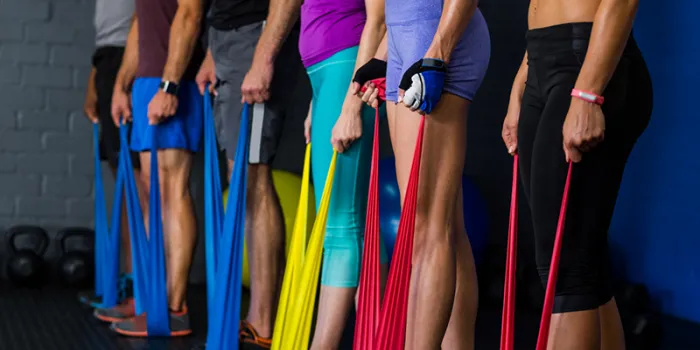Getting fit should shrink your waist, not your wallet. Commercial gyms and fancy equipment are fine if you can afford them, but some of the most effective equipment is also some of the least expensive.
Physical therapists count resistance bands and exercise balls among their favorites for patients with bleeding disorders. They are low impact, and that means low risk. And they’re both easy to find and easy to afford. They sell for under $20 apiece at general merchandise stores. Bands and balls are ideal for the home, where there’s no commute and no monthly fee. All you have to do is clear a space and get started.
Resistance Bands
Resistance bands are elastic rubber strips or tubing, often with handles at either end. Don’t be deceived by their simplicity; they offer excellent strength training and muscle-toning workouts. Physical therapist Angie Forsyth, PT, DPT, is a big fan. “Using resistance bands builds strength in muscles that support problem joints, and that helps prevent bleeds,” she says. Forsyth works at the Penn Comprehensive Hemophilia and Thrombosis Program in Philadelphia. “They are also really easy to use and you can carry them anywhere. The one thing you can’t do is make excuses.”
Resistance bands can be used for a variety of exercises, but each involves the same concept. You anchor the bands—on a door or under your feet or simply by holding them in your hands—and pull. This works muscles in your shoulders, arms, legs, abdomen and just about any other place in your body.
Used regularly, the bands will build your strength. Soon you will graduate from bands that offer light resistance to those that are more challenging and more muscle building. In general, the level of resistance is color-coded, but the color coding varies by manufacturer.
Forsyth recommends talking with your own physical therapist to set up a resistance band routine that is right for you. Your routine should take into account any problem joints you have, as well as your current strength and abilities. “I practice everything with my patients to make sure they are doing it right,” Forsyth says. “You need to have the right form, and you need to have control.”
Exercise Balls
Exercise balls, also called Swiss balls or stability balls, are inflatable, lightweight and bouncy. They don’t cost much but provide good results. Physical therapists like them because they can work wonders on an often neglected muscle group, your “core.” Strengthening your core, which includes muscles in your abdomen and back, can boost your balance and make most physical activities easier and safer. A strong core can improve your posture, lower your risk of back pain and help prevent muscle injuries.
[Steps for Living: Maintaining a Healthy Body]
“Most people have weak core muscles,” says Ruth Mulvany, DPT, MS, PT, physical therapist for the University of Tennessee Comprehensive Hemophilia Clinic. She is an associate professor in the physical therapy department at the University of Tennessee. “They don’t think about controlling their middle.”
Working out on a ball, however, leaves you no choice but to control your middle. The simple effort of keeping your balance gives your core a solid workout. If you are unable to maintain your balance, you’ll roll off the ball—which is why it’s also important to monitor children who use it.
There are many exercises you can do with a ball, from abdominal crunches to back extensions. A patient of Mulvany’s used one to do pushups. Lying with the ball under his stomach, he lowered himself partway to the floor. That way, he could work his muscles without the strain of a straight pushup. “The ball not only absorbed some of his weight, making the exercise less strenuous, but it also helped stabilize his core,” Mulvany says.
Even couch potatoes can benefit from exercise balls. Simply sitting on the ball and keeping it steady will build core strength. Just make sure to buy the right ball for you. (See “Learn More” on how to select the correct size.)
Although many people find exercising on a ball fun and comfortable, you do get a real workout. As with any new workout, physical therapists caution you to go slowly. Exercise at least three times a week, but build your stamina gradually and don’t work the same muscle group two days in a row. For example, if you work your upper body one day, focus on your lower body during your next workout.
Stretching Toward a Goal
Both Mulvany and Forsyth encourage the use of novel exercise equipment and strategies to keep things interesting. Forsyth advises her patients to scan their kitchen pantries for workout props. “Do a bicep curl with a small can of spaghetti sauce,” she suggests. “Anything that adds resistance will add to your workout.”
Mulvany likes to keep exercises simple. “We tend to think exercise has to happen in a gymnasium with very expensive equipment,” she says. But resistance bands and stability balls prove otherwise.
Guy Law, a 25-year-old theater manager in Erie, Pennsylvania, has severe hemophilia A, which he says kept him sedentary for too long. Once he made up his mind to get in shape, though, he learned how much he could do at home. He particularly liked using resistance bands.
“I wanted to get off the couch and be more active,” Law says. “Resistance bands gave me a good workout.”

